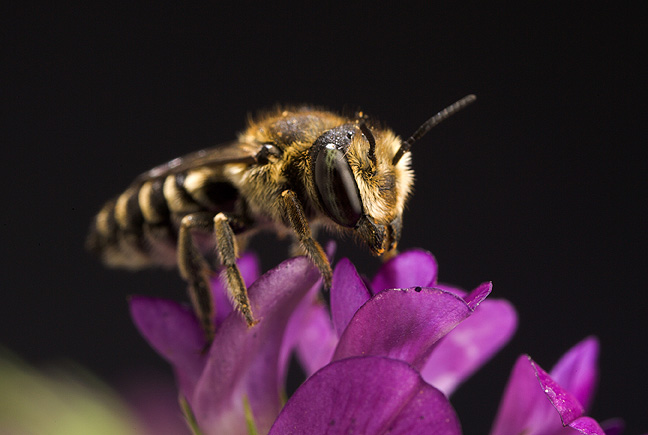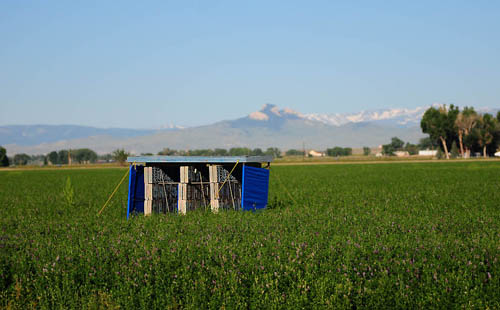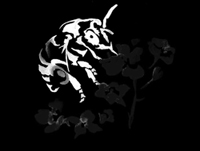Alfalfa leafcutting bee (Megachile rotundata Fab.)

An alfalfa leafcutting bee
Like the blue orchard bee, the alfalfa leafcutting bee is a solitary bee in the family Megachilidae. This species was introduced to North America from Europe after a calamitous drop in alfalfa seed production in the middle of the last century.
The drop in alfalfa seed production was related to a large increase in alfalfa acreage. Small fields, with a high quantity of edge habitat relative to their area, were well serviced by wild pollinators. In large fields, however, yields declined away from the field edges, until practically no seed was produced more than 75-100m from the surrounding natural habitat.
Honey bees were poor substitutes for alfalfa leaf cutting bees for alfalfa pollination because alfalfa flowers have a tripping mechanism that usually requires pollination by a large bee. Honey bees are reluctant pollinators of this crop because it appears they are averse to being struck forcefully under the head with the stamens when the flower is tripped. They usually learn to access the alfalfa nectar without tripping the flower, and therefore avoiding moving pollen.
To compensate for a lack of wild alfalfa leafcutting bees in large fields, producers place leafcutting bee domiciles (which have gradually reached the size of truck trailers) in the alfalfa fields. This was the first, and to date the most successful, use of a cavity nesting solitary bee for managed pollination in North America. There is on-going study into their usefulness for other crops, including orchard fruit and berry crops.

Leafcutting bee shelter in field (photo by Rob Koelling)
Problems have emerged in the alfalfa leafcutting bee industry due to the high density under which the bees work and are stored. Chalkbrood, a fungal infection similar to the disease of the same name that affects honey bees, is highly virulent to alfalfa leafcutting bees. In addition, the parasitic wasp Pteromalus venustus parastizes developing bees, killing them. Finding methods to control these parasites is difficult, and generally requires the use of the insecticide dichlorvos (Vapona®). Its use must be carefully timed so as to kill the parasite but not harm the bees.
To make sure that commercially managed leafcutting adults emerge at the right time for crop bloom, the temperature of brood chambers can be manipulated. Cocoons are placed into domiciles and set in the field before the adults emerge. Females will return to where they emerged to lay their eggs, and the next generation of cocoons can be recovered and stored for use next season. Nest blocks that are full should be removed from the field, to protect them from insectivorous birds.
Alfalfa leafcutting bee cells (cocoons) generally cost around $100 per gallon bucket (i.e., approx. 10,000 healthy prepupae), although prices have increased over the last few years. Expect to use two gallons per acre (5 gallons per hectare) for alfalfa pollination, spaced appropriately throughout the field so that no part of the field is more than about 50m from a bee domicile.
Leafcutting bee cocoons; note leaves used in construction (photo by Margriet Dogterom)
See also Vendor - Managed Pollinators.
References
Bosch, J. & Kemp, W.P. 2005. Alfalfa leafcutting bee population dynamics, flower availability, and pollination rates in two Oregon alfalfa fields. Journal of Economic Entomology 98:1077-1086.
Pitts-Singer, T.L. & Cane, J.H. 2011. The alfalfa leafcutting bee, Megachile rotundata: the world’s most intensively managed solitary bee. Annual Review of Entomology 56:221-237.
**For more detailed information and references, download the following: Woodcock, T.S. 2012. Pollination in the agricultural landscape: best management practices for crop pollination. University of Guelph. 113 pp.
